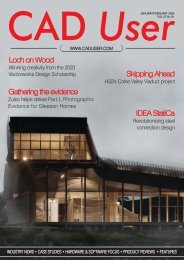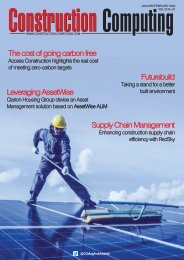Create successful ePaper yourself
Turn your PDF publications into a flip-book with our unique Google optimized e-Paper software.
CASEstudy<br />
Rapid 3D scans<br />
Trimble laser scanning technology delivers high-precision surveys for a historic church restoration<br />
In 2021 a team of geospatial mapping<br />
specialists visited the 900-year-old<br />
Newcastle Cathedral Church of St<br />
Nicholas. The company, Gridmark<br />
Survey, was there to use a new state-ofthe-art<br />
3D laser scanning technology in<br />
the restoration of the cathedral. They<br />
would assist Historic Property Restoration<br />
and Classic Masonry with site<br />
engineering. Gridmark would provide<br />
dimensional marking of the groundworks<br />
and paving to the new outdoor terrace in<br />
the Cathedral churchyard.<br />
The firm was using the new Trimble X7<br />
laser scanning system, a high-precision,<br />
rapid-fast modern laser scanner, which<br />
captures millimeter-accurate reality data.<br />
Gridmark collaborated with KOREC<br />
Group, the UK Trimble distributor who<br />
provided the technology. The Trimble X7<br />
3D laser scanner is integrated with<br />
Trimble's Perspective software and<br />
specifically designed for in-field control<br />
and registration.<br />
"We knew we could revolutionise how<br />
the stonework was inspected and<br />
measured and show that we could speed<br />
up the process by more accurately<br />
measuring the masonry without<br />
scaffolding and additional labor," said<br />
Christopher Mooney, managing director<br />
and senior surveyor with Gridmark<br />
Survey. Safety was also important to<br />
Gridmark but the X7's remote sensing<br />
capability eliminated the need for safety<br />
training, saving valuable worker time.<br />
The scanning team consisted of two<br />
surveyors on site for three days. During that<br />
time, they captured details of the building's<br />
14th-century interior. "We collected 104<br />
laser scans and 3.7 billion measurable<br />
points," Mooney said. "There were three or<br />
four rooms not accessible, or it would have<br />
been 110 scans and 4 billion points."<br />
In some places, pollution had eaten<br />
away much of the stonework. With the X7<br />
they could zoom in on an area and<br />
provide details of the damage<br />
immediately. "One window was extremely<br />
deteriorated on the outside but beautiful<br />
inside so you could see how it was<br />
supposed to look," Mooney said. "That<br />
level of detail captured by the scanner<br />
was phenomenal.<br />
"It would take a stonemason six weeks<br />
to inspect and measure what we<br />
scanned in three days with the Trimble X7<br />
scanner," Mooney added.<br />
Gridmark also had access to the<br />
Cathedral's Lantern Tower, a climb of 162<br />
steps. They set up the scanner and<br />
captured 360-degree scans from the<br />
tower, the roof and the adjacent buildings.<br />
Each time they moved to a new position,<br />
the X7 automatically leveled and<br />
calibrated itself and the Perspective<br />
software automatically registered each<br />
scan, allowing them to review everything<br />
in 3D before moving on.<br />
Once the scanning was complete,<br />
Gridmark imported the data into Trimble<br />
RealWorks® software to create a 3D<br />
capacity for making a point cloud as well<br />
as a scaled digital model of the<br />
Cathedral. Creating a 3D representation<br />
of the Cathedral ensured that the detail<br />
and design was preserved forever.<br />
"The scanner is so quick. The user<br />
interface is very intuitive, and we like the<br />
high-sensitivity mode that allows us to<br />
capture difficult surfaces. We also like the<br />
ability to flip between different scans to<br />
see more detail," added Mooney.<br />
"We were blown away by the data we<br />
downloaded at the end of the day," he<br />
noted. "Trimble RealWorks has the<br />
capability to make point clouds look very<br />
much like real life. We ended up with<br />
data so rich it was hard to know what to<br />
choose to share with the client. What<br />
was most important, though, was that we<br />
had absolute confidence in the results.<br />
We knew that 900 years of heritage had<br />
been safeguarded."<br />
www.Trimble.com<br />
34<br />
<strong>Jan</strong>uary/<strong>Feb</strong>ruary <strong>2022</strong>

















